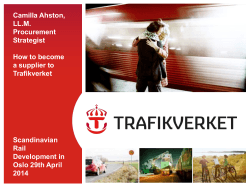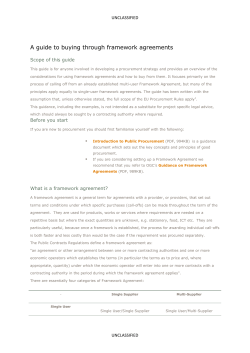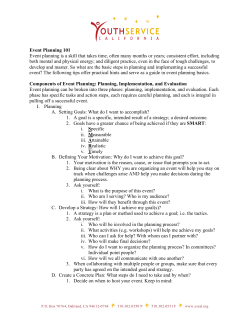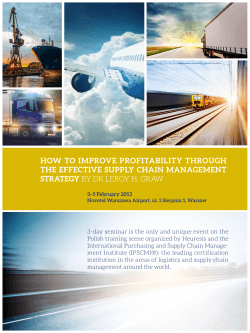
A PM.01 How to Create a World Class Project Management Organization
2006 AACE International Transactions PM.01 How to Create a World Class Project Management Organization Dr. Nick J. Lavingia, PE company that consistently selects the right projects and executes them with excellence can improve return on capital employed (ROCE) and ultimately total shareholder return (TSR). In today's competitive capital intensive business environment companies need to implement project management best practices in order to survive and flourish long-term. This practical paper focuses on how to create a world class project management organization. Five key steps to success are: common language, structured project development and execution process, application of value improving and best practices, and total cost management and training and certification. The formula for creating a world class project management organization is simple. However, implementation of these concepts is a big challenge. A Step 1: Common Language Project Management Institute (PMI) has developed a guide to the project management body of knowledge (PMBOK) that focuses on nine knowledge areas: integration, scope, time, cost, quality, human resource, communications, risk and procurement [1]. The PMBOK includes knowledge of proven practices and provides a common language in the field of project management. The PMBOK guide is also used by PMI to provide a consistent structure for development of its project management professional (PMP) certification program. Step 2: Structured Project Development & Execution Process (PDEP) In order for any project management system to be successful, it needs to follow a structured process. PDEP is a process that facilitates the optimal use of resources (people, money, and technology) over the life of a project to maximize value. The desired outcomes of this process are to select the right projects by improvBUSINESS CASE FOR IMPROVEMENT ing decision-making and to improve project outcomes through Effective project management improves ROCE by increasing excellence in execution. Figure 1 summarizes the deliverables of revenues, decreasing expenses and reducing capital employed. a structured five-phase process. The five phases of PDEP are: ROCE is a common metric in the industry to measure capital effi• Phase 1—Identify and assess business opportunity; ciency. Projects are the vehicle by which we turn business opportu- • Phase 2—Select from alternatives; nities into valued business assets. Successful projects are defined • Phase 3—Develop preferred alternative for full funding; as the ones that are delivered on time, within budget and meet • Phase 4—Execute (detail design, procurement and construction); established business objectives. If a company selects and executes good projects, it can increase revenues, decrease life cycle costs, • Phase 5—Operate and evaluate. operating and maintenance costs, and use less capital to achieve The first three phases of PDEP prior to full funding step are its business goals. referred to as front end loading (FEL) and are crucial in determining project success. Industry benchmarking data from Independent Project Analysis (IPA) Inc. has statistically validated STEPS IN CREATING WORLD CLASS PROJECT the correlation of FEL to project outcomes for cost, schedule and MANAGEMENT ORGANIZATION performance [2]. The five-phase gated process provides a mechanism for effecThe five steps in creating a world class project management organization are common language, structured project develop- tive communication between decision-makers, multifunctional ment and execution process, application of value improving and project team members, business, technical, operations, maintebest practices, total cost management and training and certifica- nance, etc., and stakeholders to achieve business success. tion. PM.01.1 2006 AACE International Transactions Step 3: Application of Value Improving / Best Practices Value improving and best practices in conjunction with a structured process can help achieve world class performance. Effective application of these practices can optimize cost, schedule, performance and safety aspects of any project. Figure 2 shows the timing of these value improving and best practices on a PDEP roadmap. D&RA is a process to compare and decide among various alternatives by quantifying risks and uncertainties inherent in financial outcomes of the alternatives. Tools such as strengths, weaknesses, opportunities and threats (SWOT) analysis, decision hierarchy, strategy table, influence diagram, tornado diagram, decision tree and S-curve are used to communicate most likely, optimistic and pessimistic outcomes of any decision. Decision and Risk Analysis (D&RA)—Building wrong proj- Project Execution Planning (PEP)—PEP is a tool for strategic ects less expensively is not much help! We want to select the right planning whose purpose is to maximize the probability of project success. Once a good quality decision is made using the D&RA projects and execute them with excellence. Figure 1—Project Development and Execution Process (PDEP) Figure 2—Value Improving/Best Practices PM.01.2 2006 AACE International Transactions Figure 3—Total Cost Management PEP is a living document that is kept current throughout the process, the multifunctional project team should kick off the project with a PEP workshop. The topics covered in PEP workshops life of the project. It serves as an excellent source for communication between the project team, decision-makers and stakeholders. are (3): Part A: Defining the Vision of Success • • • Business goals Project objectives and drivers Scope of work Lessons Learned—Project teams starting a new project should actively search for applicable lessons from past projects and then proactively apply those lessons. At the end of the project, they should capture lessons learned from their project including things that went well and opportunities for improvement, and then share those lessons with other projects. Part B: Defining the Strategy for Success • • • • • • Management level plan Risk Management plan Organization plan Contract plan Best practices implementation plan Team performance management plan Part C: Defining the Tools for Success • • • • • • Time management plan Cost management plan Quality management plan Safety and environmental management plan Materials management plan Communications management plan Value Improving Practices (VIPs)—IPA has statistically shown the benefits of implementing VIPs based on their vast database of past completed projects in the industry. The optimum time for implementing these VIPs is during FEL prior to full funding of the project. The VIPs that add value are classes of facility quality, constructability reviews, customizing standards and specifications, design-to-capacity, energy optimization, predictive Maintenance, process simplification, reliability simulation modeling, technology selection, value engineering, waste minimization and 3-D computer aided design. Peer Review—The goal of a peer review conducted by an independent team is to constructively challenge the project team's assumptions, alternatives considered, decision logic and path forward. Peer reviews are also an excellent mechanism to share lessons learned across the corporation. PM.01.3 2006 AACE International Transactions Pre-Funding Assessment—An assessment of project progress Benchmarking—Benchmarking is a forward-looking quantiand quality performed at the end of phase 3 of PDEP. It rates the project against database of similar projects and recommends cost tative approach based on the experience of past projects in the industry. This information should help in determining what the contingency and schedule. competition would spend on a similar project and how long they Post Project Assessment—This assessment compares end of would take to execute. It also should assist the project team in setproject data to the appropriation for expenditure (AFE) data that ting challenging pacesetter project performance targets. was approved at full funding at the end of phase 3 of PDEP. This Contracting/Procurement—Contracting and procurement information is used to update the database, which in turn will comprise a significant portion of many projects. Contracting and help improve cost estimates and schedules for future projects. procurement plans include process required to acquire goods and Business Evaluation—Business evaluation should be con- services from outside the performing organization. ducted 1 to two years after project completion to validate volumes, Typical steps in the contracting and procurement process are preprices, margins, operating costs and economic indicators. The qualification, bidding and negotiating, evaluation and agreement, project sponsor is responsible for this review. This practice brings execution and administration. The contracting strategy for lump sum, reimbursable, unit price or Incentive contracts depends on accountability into the overall process. several factors such as scope definition, market conditions and risk tolerance. Step 4: Total Cost management (TCM) Performance Measurement—Performance measurement TCM converts the optimized scope into cost and schedule. TCM not only helps us in planning, scheduling and estimating a uses the earned-value concept to track physical progress based on well defined project before full funding, it also helps us monitor pre-determined milestones. A plot of budget, earned and actual progress through the execution phase of the project. Figure 3 cost is used to measure performance versus the plan. This information is proactively used to take corrective action on cost and shows the timing of these TCM tools on a PDEP Roadmap. schedule. Economic Analysis—Economic analysis compares net presCost Control/Forecasting—Cost control and forecasting ent value (NPV), rate of return (ROR), discounted profitability index (DPI) and payout of projects and helps us determine the uses tools and procedures to track budgets and report expenditures portfolio of projects that will maximize value for the corporation. and commitments against a work breakdown structure (WBS). It uses a trending process to forecast final project cost. Cost Estimating—A cost estimate should reflect the best Progress Reporting—A good progress report should include numbers based on the scope definition at any stage of project development. It should address the risks involved by clearly artic- current and accurate information on the status of the project-plan ulating the contingency and accuracy of the estimate. Estimates versus actual data on scope, cost, schedule and safety incidents. Finance/Audit—All of the project cost data has ultimately should be presented with the most likely number, the median (P50), the optimistic number (P10) and the pessimistic number got to be converted into asset accounting. Project costs are typi(P90). These numbers capture 80 percent confidence interval for cally divided into two categories, namely capital and expense. the estimate. The only time we will know the final exact number Capital money has to be depreciated over the life of the asset whereas expense money can be written off in the year it is spent. is at the end of the project. Contingency by far is the most misunderstood term in the indus- The project team has to keep accurate cost data in order to suptry. Projects are funded at P50 level to maximize capital utiliza- port Finance Audit. tion for the corporation. Contingency or float is added to estimates to reduce the risk of cost overrun or schedule delay. Step 5: Training / Certification In today's fast paced world, learning is an ongoing process. In Planning/Scheduling—Planning defines all the project activities, links the activities into a network structure to show inter- order to achieve world class project performance, the decisiondependencies and then assigns duration and resources to the makers and project professionals need training and certification in activities. Scheduling takes the plan and assigns dates on which decision and risk analysis and leadership roles and behaviors. each activity will be performed. Critical path method (CPM) Additionally, the project professionals need training and certificatechnique uses a network schedule to determine the activities that tion in all the PMBOK knowledge areas. combine to make a "critical path" such that if one activity on the critical path slips, the project end date will slip. A resource loaded critical path schedule should be developed prior to full funding of ith the implementation of common language, a project. The actual schedule during the execution phase of the structured project development and execution project should be compared to the target schedule and corrective process, application of value improving and best actions should be taken on an ongoing basis. The required corpractices, total cost management and training rective actions may include changing resources or logic between and certification, a company can achieve world-class performthe activities. W PM.01.4 2006 AACE International Transactions ance-better, cheaper, faster and safer projects than the competition. ACRONYMS • • • • • • • • • • • • • • • • AFE = Appropriation for Expenditures CPM = Critical Path Method D&RA = Decision and Risk Analysis DPI = Discounted Profitability Index FEL = Front End Loading IPA = Independent Project Analysis, Inc. NPV = Net Present value PDEP = Project Development and Execution Process PEP = Project Execution Planning PMP = Project Management Professional ROCE = Return on Capital Employed ROR = Rate of Return SWOT = Strengths, Weaknesses, Opportunities and Threats TSR = Total Shareholder Return VIP = Value Improving Practices WBS = Work Breakdown Structure REFERENCES 1. 2. 3. Project Management Institute (PMI). Independent Project Analysis (IPA) Inc., Ashburn, Virginia. Westney, Richard E., The Strategic Project Planner, Marcel Dekker, Inc. (2000). Dr. Nick J Lavingia, PE Project Management Consultant Chevron 6001 Bollinger Canyon Road, L-4188 San Ramon, CA 94583-2324 Phone: 925-842-9868 Email: njla@chevron.com PM.01.5
© Copyright 2025
















